溶剂萃取基本原理 - Phil
溶剂提取发的基本原理

溶剂提取发的基本原理
溶剂提取是一种常用的分离和提纯技术,基于不同物质在溶剂中的溶解度差异,利用溶剂对混合物进行分离的原理。
它适用于多种领域,包括化学、药学、食品科学等。
溶剂提取的基本原理可以总结为以下几个方面:
1. 溶解性差异:不同的化合物在不同溶剂中的溶解度往往不同。
通过选择合适的溶剂,可以使目标物质在溶剂中溶解,而其他杂质则不溶解。
2. 分配系数:分配系数是指溶质在两相间的分配情况。
通过在两相之间进行反复摇匀,并考虑了分配系数的差异性,使得目标物质尽可能地从原始混合物中转移到溶剂中。
3. 选择合适的溶剂:溶剂的选择对提取效果至关重要。
合适的溶剂应该满足以下条件:与目标物质有良好的相容性,溶解度适中,在操作温度下具有较低的挥发性和毒性。
4. 溶剂回收:溶剂提取通常会使用大量的溶剂。
为了减少成本和环境影响,溶剂的回收非常重要。
回收方法包括蒸馏、结晶和浓缩等。
需要注意的是,溶剂提取虽然是一种有效的分离技术,但也存在一些局限性。
比
如,溶剂提取可能会导致某些物质损失或分解,同时也可能提取到一些非目标物质。
因此,在实际应用中需要根据具体情况进行优化和控制,以达到理想的提取效果。
简述溶剂萃取法的原理及应用

简述溶剂萃取法的原理及应用1. 引言溶剂萃取法是一种常用的分离纯化技术,广泛应用于化学、生物化学、环境科学等领域。
本文将对溶剂萃取法的原理及应用进行简要介绍。
2. 原理溶剂萃取法基于物质在两种不相溶的相中分配系数不同的原理。
通常包括以下几个步骤:•第一步,将待分离的混合物溶于合适的有机溶剂中,形成有机相;•第二步,将产生的有机相与其他相进行搅拌和分离,使分离物在不同相中分配;•第三步,将有机相从混合物中分离出来;•第四步,再通过溶剂蒸发或其他方式将溶剂从有机相中去除,得到目标物质。
3. 应用溶剂萃取法在以下领域得到广泛应用:3.1 化学分析领域在化学分析中,溶剂萃取法可以用于分离和富集待测物质。
例如,在环境样品中检测有机污染物时,通过溶剂萃取法可以将目标物质从复杂的样品基质中分离出来,提高检测的灵敏度和准确性。
3.2 制药工业在制药工业中,溶剂萃取法常用于从发酵液或合成反应体系中提取目标物质。
通过与溶剂的相互作用,将目标物质从反应混合物中富集和纯化,可以在后续工艺中提高产率和产品质量。
3.3 环境科学在环境科学研究中,溶剂萃取法可用于水体、土壤等环境样品中分离和富集目标污染物。
通过调整溶剂的选择和条件,可以实现对不同种类污染物的高效提取和浓缩,为环境污染的监测和治理提供技术支持。
3.4 食品工业溶剂萃取法在食品工业中常用于提取和分离天然产物。
例如,从植物中提取活性成分、从奶制品中提取脂肪等。
通过合适的溶剂选择和操作条件,可以实现对食品中目标物质的高效提取和纯化。
3.5 其他领域此外,溶剂萃取法在石油化工、化妆品、医药研发等领域也有广泛应用。
在石油化工中,溶剂萃取法可用于原油中某一组分的分离;在化妆品和医药研发中,溶剂萃取法可用于纯化天然成分或合成物质。
4. 总结溶剂萃取法作为一种常用的分离纯化技术,具有广泛的应用前景。
通过对不同溶剂特性及条件的选择,可以实现对目标物质的高效提取和分离。
在化学分析、制药工业、环境科学、食品工业等领域都有着重要的作用。
溶剂萃取原理
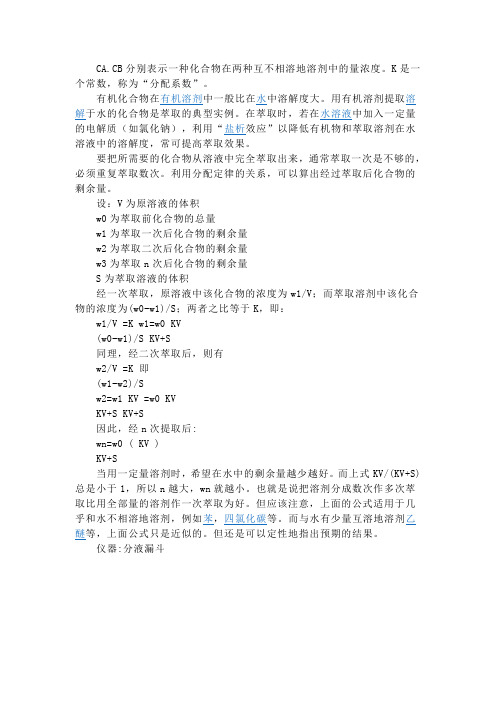
原理示意图利用化合物在两种互不相溶(或微溶)的溶剂中溶解度或分配系数[1]的不同,使化合物从一种溶剂内转移到另外一种溶剂中。
经过反复多次萃取,将绝大部分的化合物提取出来。
分配定律是萃取方法理论的主要依据,物质对不同的溶剂有着不同的溶解度。
同时,在两种互不相溶的溶剂中,加入某种可溶性的物质时,它能分别溶解于两种溶剂中,实验证明,在一定温度下,该化合物与此两种溶剂不发生分解、电解、缔合和溶剂化等作用时,此化合物在两液层中之比是一个定值。
不论所加物质的量是多少,都是如此。
属于物理变化。
用公式表示。
CA/CB=KCA.CB分别表示一种化合物在两种互不相溶地溶剂中的量浓度。
K是一个常数,称为“分配系数”。
有机化合物在有机溶剂中一般比在水中溶解度大。
用有机溶剂提取溶解于水的化合物是萃取的典型实例。
在萃取时,若在水溶液中加入一定量的电解质(如氯化钠),利用“盐析效应”以降低有机物和萃取溶剂在水溶液中的溶解度,常可提高萃取效果。
要把所需要的化合物从溶液中完全萃取出来,通常萃取一次是不够的,必须重复萃取数次。
利用分配定律的关系,可以算出经过萃取后化合物的剩余量。
设:V为原溶液的体积w0为萃取前化合物的总量w1为萃取一次后化合物的剩余量w2为萃取二次后化合物的剩余量w3为萃取n次后化合物的剩余量S为萃取溶液的体积经一次萃取,原溶液中该化合物的浓度为w1/V;而萃取溶剂中该化合物的浓度为(w0-w1)/S;两者之比等于K,即:w1/V =K w1=w0 KV(w0-w1)/S KV+S同理,经二次萃取后,则有w2/V =K 即(w1-w2)/Sw2=w1 KV =w0 KVKV+S KV+S因此,经n次提取后:wn=w0 ( KV )KV+S当用一定量溶剂时,希望在水中的剩余量越少越好。
而上式KV/(KV+S)总是小于1,所以n越大,wn就越小。
也就是说把溶剂分成数次作多次萃取比用全部量的溶剂作一次萃取为好。
但应该注意,上面的公式适用于几乎和水不相溶地溶剂,例如苯,四氯化碳等。
溶剂萃取知识点总结
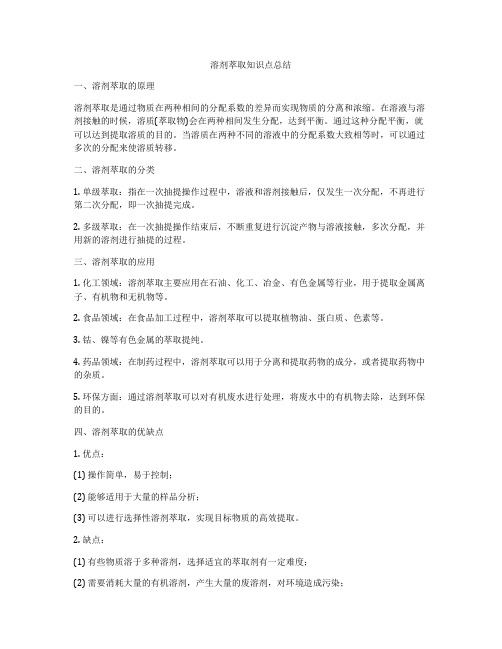
溶剂萃取知识点总结一、溶剂萃取的原理溶剂萃取是通过物质在两种相间的分配系数的差异而实现物质的分离和浓缩。
在溶液与溶剂接触的时候,溶质(萃取物)会在两种相间发生分配,达到平衡。
通过这种分配平衡,就可以达到提取溶质的目的。
当溶质在两种不同的溶液中的分配系数大致相等时,可以通过多次的分配来使溶质转移。
二、溶剂萃取的分类1. 单级萃取:指在一次抽提操作过程中,溶液和溶剂接触后,仅发生一次分配,不再进行第二次分配,即一次抽提完成。
2. 多级萃取:在一次抽提操作结束后,不断重复进行沉淀产物与溶液接触,多次分配,并用新的溶剂进行抽提的过程。
三、溶剂萃取的应用1. 化工领域:溶剂萃取主要应用在石油、化工、冶金、有色金属等行业,用于提取金属离子、有机物和无机物等。
2. 食品领域:在食品加工过程中,溶剂萃取可以提取植物油、蛋白质、色素等。
3. 钴、镍等有色金属的萃取提纯。
4. 药品领域:在制药过程中,溶剂萃取可以用于分离和提取药物的成分,或者提取药物中的杂质。
5. 环保方面:通过溶剂萃取可以对有机废水进行处理,将废水中的有机物去除,达到环保的目的。
四、溶剂萃取的优缺点1. 优点:(1) 操作简单,易于控制;(2) 能够适用于大量的样品分析;(3) 可以进行选择性溶剂萃取,实现目标物质的高效提取。
2. 缺点:(1) 有些物质溶于多种溶剂,选择适宜的萃取剂有一定难度;(2) 需要消耗大量的有机溶剂,产生大量的废溶剂,对环境造成污染;(3) 萃取后需要进行进一步的溶剂回收和废弃物处理,增加了操作成本。
五、溶剂萃取的过程及步骤1. 与样品混合:将样品和适量的溶剂混合,在搅拌或加热的条件下使之充分混合。
2. 分液:待混合物充分混合后,静置一段时间,使得样品中的目标物质与溶剂达到分配平衡,产生两个不同相的层。
3. 采集上层液:通过分液漏斗或者其他分离设备采集上层液相。
4. 净化:对采集的上层液做进一步的处理和净化,使得目标物质得到更纯净的提取。
溶剂萃取原理

溶剂萃取原理溶剂萃取是一种常用的化学分离技术,它利用不同物质在不同溶剂中的溶解度差异,通过分配系数来实现物质的分离和提纯。
溶剂萃取原理是基于溶质在两种不同溶剂中的溶解度不同而进行分离的。
在溶剂萃取过程中,通常会选择两种互不相溶的溶剂,一种是水相溶剂,另一种是有机相溶剂。
首先,溶剂萃取原理的关键在于选择合适的溶剂。
对于溶质A 和B来说,如果A在水相中溶解度较高,而B在有机相中溶解度较高,那么就可以利用这一特性进行分离。
其次,将混合物与合适的溶剂进行接触,使得溶质A和B分别溶解在不同的溶剂中。
然后,通过分液漏斗等设备将两种溶剂分离开来,从而实现溶质A和B的分离。
在实际应用中,溶剂萃取广泛应用于化工、生物制药、环境保护等领域。
例如,在化工生产中,可以利用溶剂萃取技术从废水中提取有价值的物质;在生物制药领域,可以利用溶剂萃取技术提取生物制剂中的有效成分。
此外,溶剂萃取还可以用于金属提取、食品加工等方面。
在实际操作中,溶剂萃取过程中需要考虑一些因素。
首先,选择合适的溶剂对于溶剂萃取的效果至关重要。
其次,要控制好溶剂的使用量和分离条件,以提高分离效率和降低成本。
最后,对于有机相溶剂的回收和再利用也是一个重要的环节,可以通过蒸馏等方法将有机相溶剂回收,减少资源浪费。
总的来说,溶剂萃取原理是一种简单而有效的物质分离技术,通过选择合适的溶剂和控制好分离条件,可以实现对混合物中不同物质的高效分离和提纯。
在实际应用中,溶剂萃取技术具有广泛的应用前景,对于化工、生物制药、环境保护等领域都具有重要意义。
通过不断的研究和改进,相信溶剂萃取技术将会在更多领域发挥重要作用。
化学技术中的溶剂萃取技术原理与应用
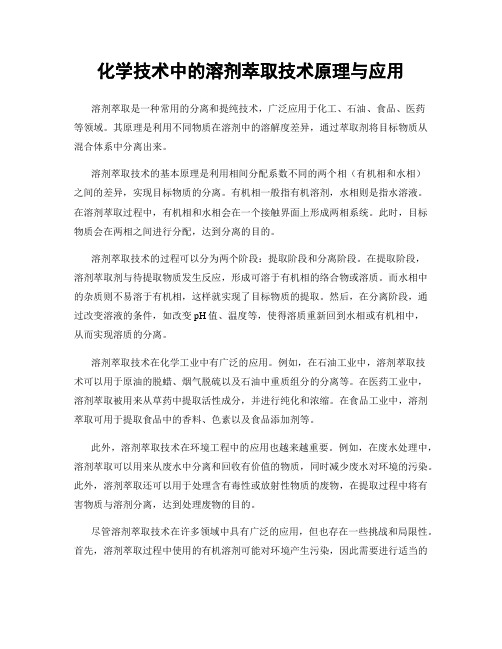
化学技术中的溶剂萃取技术原理与应用溶剂萃取是一种常用的分离和提纯技术,广泛应用于化工、石油、食品、医药等领域。
其原理是利用不同物质在溶剂中的溶解度差异,通过萃取剂将目标物质从混合体系中分离出来。
溶剂萃取技术的基本原理是利用相间分配系数不同的两个相(有机相和水相)之间的差异,实现目标物质的分离。
有机相一般指有机溶剂,水相则是指水溶液。
在溶剂萃取过程中,有机相和水相会在一个接触界面上形成两相系统。
此时,目标物质会在两相之间进行分配,达到分离的目的。
溶剂萃取技术的过程可以分为两个阶段:提取阶段和分离阶段。
在提取阶段,溶剂萃取剂与待提取物质发生反应,形成可溶于有机相的络合物或溶质。
而水相中的杂质则不易溶于有机相,这样就实现了目标物质的提取。
然后,在分离阶段,通过改变溶液的条件,如改变pH值、温度等,使得溶质重新回到水相或有机相中,从而实现溶质的分离。
溶剂萃取技术在化学工业中有广泛的应用。
例如,在石油工业中,溶剂萃取技术可以用于原油的脱蜡、烟气脱硫以及石油中重质组分的分离等。
在医药工业中,溶剂萃取被用来从草药中提取活性成分,并进行纯化和浓缩。
在食品工业中,溶剂萃取可用于提取食品中的香料、色素以及食品添加剂等。
此外,溶剂萃取技术在环境工程中的应用也越来越重要。
例如,在废水处理中,溶剂萃取可以用来从废水中分离和回收有价值的物质,同时减少废水对环境的污染。
此外,溶剂萃取还可以用于处理含有毒性或放射性物质的废物,在提取过程中将有害物质与溶剂分离,达到处理废物的目的。
尽管溶剂萃取技术在许多领域中具有广泛的应用,但也存在一些挑战和局限性。
首先,溶剂萃取过程中使用的有机溶剂可能对环境产生污染,因此需要进行适当的处理和回收。
其次,溶剂萃取技术在操作和控制上需要较高的技术要求,以确保提取和分离的效果。
总之,溶剂萃取技术是一种重要的化学分离技术,在许多行业中有广泛的应用。
通过深入研究和不断创新,相信溶剂萃取技术将在未来发展中展现出更多的潜力,并为改善生产效率和环境保护做出贡献。
溶剂萃取的概念及原理
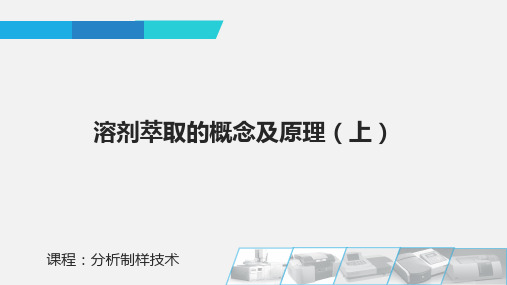
溶剂萃取的概念及原理
4、萃取过程
萃取过程可以看作是被萃物M在水相和有机相中 两个溶解过程之间的竞争。萃取过程为:
S-S + 2(M-Aq) —→ Aq-Aq + 2(M-S)
★ 有机物(包括一些在水中不离解的非极性的共价化合 物)的萃取原理适用于“相似相溶原理”。 ★ 从水溶液中将某些离子萃取到有机相,必须设法将离子 的亲水性转化为疏水性。
溶剂萃取的概念及原理
Ni2+
CH3 C N OH
+2
Ni(H2O)62+
CH3 C N OH
H
O
O
CH3 C N
N C CH3
Ni
CH3 C N
N C CH3
O
H
中和电荷
NiDx2/CHCl3
引入疏水基
萃取剂----“运载工具”
溶剂萃取的概念及原理
亲水性水合阳离子→中性疏水螯合物→萃入有机相
8-羟基喹啉
溶剂萃取的概念及原理
1、溶剂萃取的概念
(4)萃取溶剂分类:
按是否参与萃取反应分成两类: 活性溶剂—参与萃取反应,如上述乙醚; 惰性溶剂—不参与萃取反应,如上述CHCl3。
(5)萃取溶剂剂选择:
1、与原溶剂互不相溶; 2、能够溶解反应产物并与原溶剂在溶解度有较大差异。 3、粘度要小、密度与水的差别要适当。 4、毒性低、不易燃、挥发性小、易于回收的溶剂。
总结
• 1、溶剂萃取的概念
• 定义、特点、萃取剂、萃取溶剂、萃取溶剂选择
• 2、溶剂萃取的本质 • 3、物质的亲水性和疏水性 • 4、萃取过程
化学技术中的溶剂萃取技术原理与应用
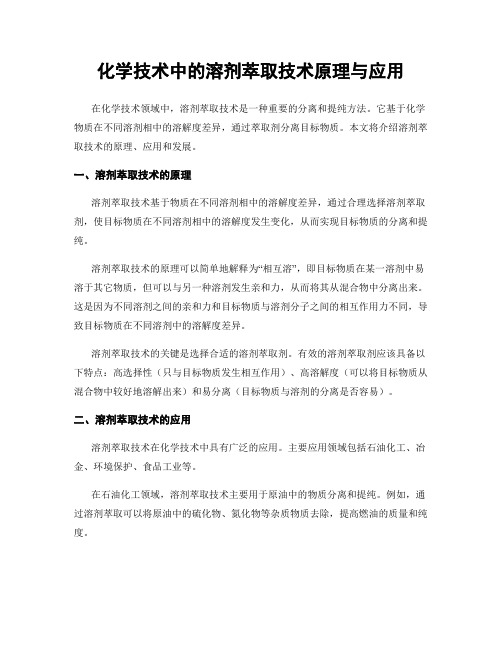
化学技术中的溶剂萃取技术原理与应用在化学技术领域中,溶剂萃取技术是一种重要的分离和提纯方法。
它基于化学物质在不同溶剂相中的溶解度差异,通过萃取剂分离目标物质。
本文将介绍溶剂萃取技术的原理、应用和发展。
一、溶剂萃取技术的原理溶剂萃取技术基于物质在不同溶剂相中的溶解度差异,通过合理选择溶剂萃取剂,使目标物质在不同溶剂相中的溶解度发生变化,从而实现目标物质的分离和提纯。
溶剂萃取技术的原理可以简单地解释为“相互溶”,即目标物质在某一溶剂中易溶于其它物质,但可以与另一种溶剂发生亲和力,从而将其从混合物中分离出来。
这是因为不同溶剂之间的亲和力和目标物质与溶剂分子之间的相互作用力不同,导致目标物质在不同溶剂中的溶解度差异。
溶剂萃取技术的关键是选择合适的溶剂萃取剂。
有效的溶剂萃取剂应该具备以下特点:高选择性(只与目标物质发生相互作用)、高溶解度(可以将目标物质从混合物中较好地溶解出来)和易分离(目标物质与溶剂的分离是否容易)。
二、溶剂萃取技术的应用溶剂萃取技术在化学技术中具有广泛的应用。
主要应用领域包括石油化工、冶金、环境保护、食品工业等。
在石油化工领域,溶剂萃取技术主要用于原油中的物质分离和提纯。
例如,通过溶剂萃取可以将原油中的硫化物、氮化物等杂质物质去除,提高燃油的质量和纯度。
在冶金领域,溶剂萃取技术被广泛应用于金属提取和分离过程。
例如,铜、镍、锌等金属的提取和分离可采用溶剂萃取技术。
此外,溶剂萃取还可以用于金属废水中有害物质的去除和回收。
在环境保护领域,溶剂萃取技术可以用于含有重金属等有害物质的废水处理。
通过调整溶剂萃取剂的选择和操作条件,可以有效地将有害物质从废水中分离出来,并实现资源的回收和废水的净化。
在食品工业领域,溶剂萃取技术常用于提取和分离食品中的营养物质和添加剂。
例如,咖啡因的提取和提纯过程常常采用溶剂萃取技术。
三、溶剂萃取技术的发展随着科学技术的不断发展,溶剂萃取技术也在不断进步和完善。
近年来,绿色溶剂萃取技术逐渐兴起,旨在减少对环境的影响和替代传统的有机溶剂。
溶剂萃取的基本原理

溶剂萃取的基本原理
溶剂萃取是一种常用的分离和纯化技术,通过溶液中不同组分在不同溶剂中的溶解度差异,利用溶剂之间的分配行为将目标物质从混合物中分离出来。
溶剂萃取的基本原理是基于溶液中的物质分子在不同溶剂中的相互分配现象。
当一个物质同时可溶于两个互不相溶的溶剂中时,它的分配系数K值定义为物质在两种溶剂中的溶解度比。
分配系数越大,表示物质在该溶剂中的溶解度越大。
在溶剂萃取过程中,首先将原始混合物溶解于一个适宜的溶剂中,形成萃取液。
然后,将萃取液与另一个互不相溶的溶剂混合,两相经过适当的搅拌和静置后分离。
通过调整溶剂体系的选择和条件,可以实现目标物质从混合物中的选择性分离。
溶剂萃取的操作步骤一般包括:混合物溶解、混合、分离和回收溶剂。
在混合物溶解阶段,将混合物加入溶剂中,经过适当的条件如温度和搅拌使混合物充分溶解。
然后,混合溶液与另一个互不相溶的溶剂混合,通过搅拌使两相充分接触。
接下来,静置让两相分离,形成有机相和水相。
最后,通过蒸馏或其他方式回收溶剂,得到目标物质。
需要注意的是,溶剂萃取过程中,选择合适的溶剂对于实现高效分离非常重要。
溶剂的选择应考虑目标物质的溶解度、选择性和回收性能。
此外,溶剂的使用还应符合环境保护和安全性的要求。
最常用的溶剂包括有机溶剂如乙酸乙酯、甲醇、乙酸丙酯等和水。
总之,溶剂萃取利用不同物质在两个互不相溶的溶剂中的分配行为,实现目标物质的选择性分离和纯化。
其基本原理是利用溶剂之间的溶质分配差异,进行溶质转移和分离。
溶剂萃取原理

溶剂萃取原理溶剂萃取是一种常见的化学分离技术,它利用不同物质在不同溶剂中的溶解度差异来实现分离和提纯。
溶剂萃取原理可以简单地概括为“相溶液中物质在两种不同的溶剂中的分配系数不同”。
在实际应用中,溶剂萃取广泛用于石油化工、生物制药、环境保护等领域,具有高效、低成本、易操作等优点。
溶剂萃取的基本原理是根据不同物质在不同溶剂中的溶解度差异来实现分离。
当混合物与溶剂接触时,各组分根据其在两种不同溶剂中的溶解度不同,分布在两种溶剂中的比例也不同。
通过调整溶剂的种类和用量,可以实现对混合物中不同组分的分离和提纯。
溶剂萃取的原理可以用分配系数来描述,分配系数(K)是指物质在两种不同溶剂中的溶解度比值。
当混合物与两种不同溶剂接触达到平衡时,各组分在两种溶剂中的浓度比例与分配系数成正比。
通过控制溶剂的种类、用量和操作条件,可以实现对混合物中目标组分的选择性萃取。
溶剂萃取的原理还涉及到溶剂的选择和混合物的处理。
溶剂的选择应考虑到目标组分在溶剂中的溶解度、挥发性、毒性等因素,以及对环境和人体的安全影响。
混合物的处理包括溶剂的加入、搅拌、分相、分离、脱溶剂等步骤,需要根据混合物的性质和目标组分的要求进行合理设计和操作。
在实际应用中,溶剂萃取广泛用于石油化工领域的原油提炼、生物制药领域的药物提取、环境保护领域的废水处理等。
例如,在原油提炼过程中,利用溶剂萃取可以实现对原油中的硫、氮、酸、金属离子等杂质的去除,提高原油的质量和降低环境污染。
在生物制药领域,利用溶剂萃取可以实现对药物中的有效成分的提取和纯化,提高药物的纯度和药效。
在环境保护领域,利用溶剂萃取可以实现对废水中的有机物、重金属离子等污染物的去除,净化水质并达到排放标准。
总之,溶剂萃取是一种重要的化学分离技术,其原理简单、操作方便、效果显著,在工业生产和科研实验中有着广泛的应用前景。
通过对溶剂的选择和操作条件的控制,可以实现对混合物中不同组分的分离和提纯,为各个领域的生产和研究提供了重要的技术支持。
溶剂萃取基本原理
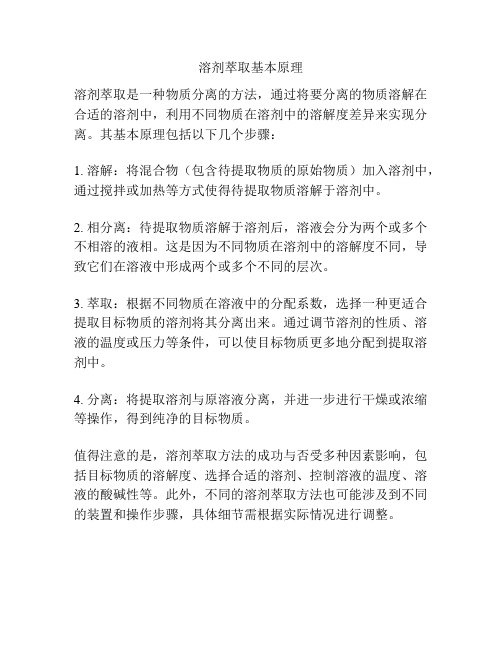
溶剂萃取基本原理
溶剂萃取是一种物质分离的方法,通过将要分离的物质溶解在合适的溶剂中,利用不同物质在溶剂中的溶解度差异来实现分离。
其基本原理包括以下几个步骤:
1. 溶解:将混合物(包含待提取物质的原始物质)加入溶剂中,通过搅拌或加热等方式使得待提取物质溶解于溶剂中。
2. 相分离:待提取物质溶解于溶剂后,溶液会分为两个或多个不相溶的液相。
这是因为不同物质在溶剂中的溶解度不同,导致它们在溶液中形成两个或多个不同的层次。
3. 萃取:根据不同物质在溶液中的分配系数,选择一种更适合提取目标物质的溶剂将其分离出来。
通过调节溶剂的性质、溶液的温度或压力等条件,可以使目标物质更多地分配到提取溶剂中。
4. 分离:将提取溶剂与原溶液分离,并进一步进行干燥或浓缩等操作,得到纯净的目标物质。
值得注意的是,溶剂萃取方法的成功与否受多种因素影响,包括目标物质的溶解度、选择合适的溶剂、控制溶液的温度、溶液的酸碱性等。
此外,不同的溶剂萃取方法也可能涉及到不同的装置和操作步骤,具体细节需根据实际情况进行调整。
溶剂萃取基本原理Phil

Strip OC – to minimise organic entrainment to EW. 反萃 有机相连续-将有机夹带入电积降到最低。
Australia
Aqueous continuous emulsion – AC 水相连续乳状液
Organic droplets surrounded by aqueous phase 有机小液滴被水相包围
Aqueous Continuous emulsion 水相连续乳状液
Desired Mixer Emulsion conditions 期望的混合室乳状液条件
铜溶剂萃取 – 化学
• 羟基肟萃取剂被用于从料液中选择性的萃取铜进入有机相;
2RH + CuSO4 → R2Cu + H2SO4
反萃有机相 + 料液
负债有机相 + 萃余液
回收有机去萃取 • 强酸被用于从有机相中反萃铜进入水相 (如, 适合于电积的电积
贫液);
R2Cu + H2SO4 → 2RH + CuSO4
• Chloride - can be transferred to EW, affecting EW and the environment. 氯-能够被传递到电积,影响电积和环境
• Manganese – can be transferred to EW and can degrade the organic phase in SX. 锰-能够被传递到电积,能够在溶剂萃取中降解有机相
Specific gravity of organic phase ~ 0.8 有机相比重~0.8
溶剂提取法的提取原理是

溶剂提取法的提取原理是
溶剂提取法是一种常用的分离和纯化化学物质的方法。
其原理基于化学物质的溶解性和亲和性差异,通过溶剂与混合物中的组分发生选择性溶解的作用,使得目标物质可以从混合物中分离出来。
具体而言,溶剂提取法的提取原理包括以下几个步骤:
1. 溶解:选择适当的溶剂,在合适的温度和压力下将混合物溶解于溶剂中。
混合物中的不同组分在溶剂中的溶解度是不同的,这种差异是溶剂提取法实现分离的基础。
2. 分相:溶解后的混合物会在溶剂中形成两个或多个不相溶的相。
其中一个相中包含了目标物质,而另一个相则主要包含了其他组分。
这些相的分离是通过它们的密度差异或其他物理性质的不同来实现的。
3. 提取:选择其中一个相作为目标物质所在的相,并将其分离出来。
这可以通过离心、过滤、蒸发、浓缩等方法来进行。
4. 分离:将提取得到的相进一步纯化,去除可能存在的杂质。
这可以通过再次进行溶解、结晶、再结晶等操作来实现。
总的来说,溶剂提取法的提取原理是基于溶剂对不同组分的选择性溶解作用,通过将目标物质转移到特定的相中,实现其有效分离和纯化。
这种方法适用于许多领域,包括化学、药物、食品、环境等。
萃取时采用有机溶剂的原理

萃取时采用有机溶剂的原理萃取过程中采用有机溶剂的原理归纳如下:
一、有机溶剂的选择
1. 根据待萃取物的极性选择适宜的有机溶剂。
2. 可调节有机溶剂极性,以提高萃取率。
如改变pH值。
3. 考虑沸点,易挥发的溶剂更便于回收。
4. 尽量选择毒性小的溶剂,减少危害。
二、溶剂萃取原理
1. 根据“相似溶解相似”原理,溶剂与待萃取物在极性上相近。
2. 溶剂分子与萃取物分子间形成分散力或偶极力相互作用。
3. 使萃取物分子从原相迁移并溶解于有机溶剂相中。
4. 通过分离提取有机相,回收萃取物。
三、提高萃取率的方法
1. 多次小批量提取,提高萃取率。
2. 萃取前适当破坏组织结构,增加接触面。
3. 提高温度或使用超声提高扩散速率。
4. 选用萃取效果佳的新型溶剂或混合溶剂。
5. 反萃取提纯,必要时变pH重新萃取。
四、有机溶剂萃取的适用性
有机溶剂萃取操作简便,可以从复杂介质中有选择性地提取目标物,是化学实验室常用的提取分离技术之一。
萃取的原理是什么
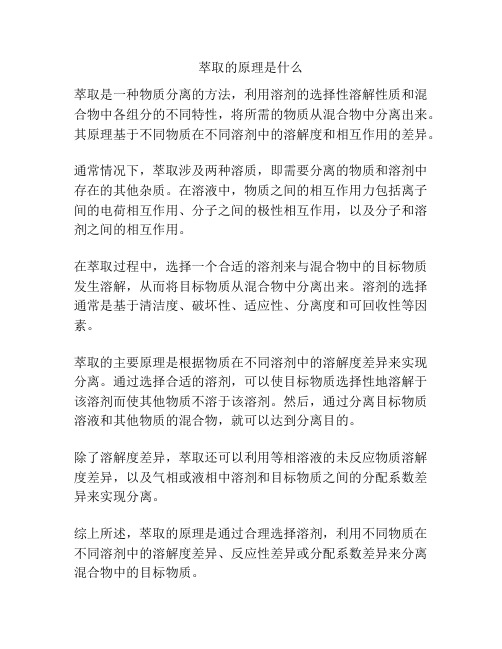
萃取的原理是什么
萃取是一种物质分离的方法,利用溶剂的选择性溶解性质和混合物中各组分的不同特性,将所需的物质从混合物中分离出来。
其原理基于不同物质在不同溶剂中的溶解度和相互作用的差异。
通常情况下,萃取涉及两种溶质,即需要分离的物质和溶剂中存在的其他杂质。
在溶液中,物质之间的相互作用力包括离子间的电荷相互作用、分子之间的极性相互作用,以及分子和溶剂之间的相互作用。
在萃取过程中,选择一个合适的溶剂来与混合物中的目标物质发生溶解,从而将目标物质从混合物中分离出来。
溶剂的选择通常是基于清洁度、破坏性、适应性、分离度和可回收性等因素。
萃取的主要原理是根据物质在不同溶剂中的溶解度差异来实现分离。
通过选择合适的溶剂,可以使目标物质选择性地溶解于该溶剂而使其他物质不溶于该溶剂。
然后,通过分离目标物质溶液和其他物质的混合物,就可以达到分离目的。
除了溶解度差异,萃取还可以利用等相溶液的未反应物质溶解度差异,以及气相或液相中溶剂和目标物质之间的分配系数差异来实现分离。
综上所述,萃取的原理是通过合理选择溶剂,利用不同物质在不同溶剂中的溶解度差异、反应性差异或分配系数差异来分离混合物中的目标物质。
萃取法的基本原理是什么
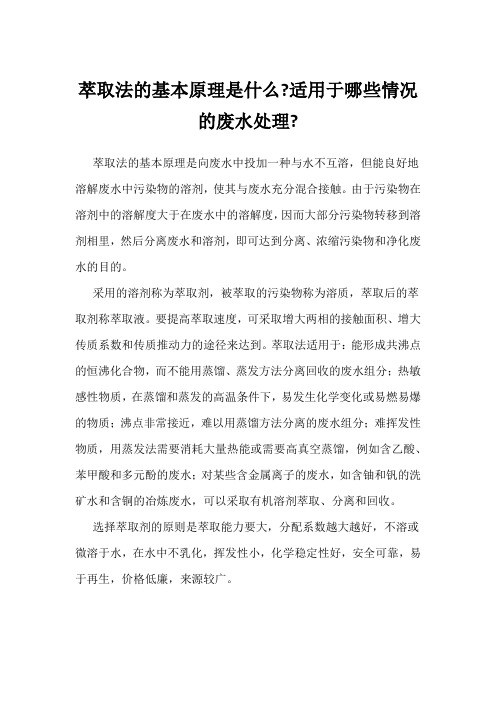
萃取法的基本原理是什么?适用于哪些情况
的废水处理?
萃取法的基本原理是向废水中投加一种与水不互溶,但能良好地溶解废水中污染物的溶剂,使其与废水充分混合接触。
由于污染物在溶剂中的溶解度大于在废水中的溶解度,因而大部分污染物转移到溶剂相里,然后分离废水和溶剂,即可达到分离、浓缩污染物和净化废水的目的。
采用的溶剂称为萃取剂,被萃取的污染物称为溶质,萃取后的萃取剂称萃取液。
要提高萃取速度,可采取增大两相的接触面积、增大传质系数和传质推动力的途径来达到。
萃取法适用于:能形成共沸点的恒沸化合物,而不能用蒸馏、蒸发方法分离回收的废水组分;热敏感性物质,在蒸馏和蒸发的高温条件下,易发生化学变化或易燃易爆的物质;沸点非常接近,难以用蒸馏方法分离的废水组分;难挥发性物质,用蒸发法需要消耗大量热能或需要高真空蒸馏,例如含乙酸、苯甲酸和多元酚的废水;对某些含金属离子的废水,如含铀和钒的洗矿水和含铜的冶炼废水,可以采取有机溶剂萃取、分离和回收。
选择萃取剂的原则是萃取能力要大,分配系数越大越好,不溶或微溶于水,在水中不乳化,挥发性小,化学稳定性好,安全可靠,易于再生,价格低廉,来源较广。
溶剂萃取的原理是什么

溶剂萃取的原理是什么
溶剂萃取是一种常见的分离和提取方法,主要基于溶解度的差异对混合物中的组分进行分离。
其原理可以简单描述如下:
1. 选择合适的溶剂:根据混合物的组成和特性,选择一个适合的溶剂或溶剂组合,使需要提取的成分在该溶剂中具有较高的溶解度。
2. 溶解过程:将混合物与溶剂混合,在适当的条件下(如温度、压力等),使溶质分子在溶剂中溶解。
3. 分相过程:由于混合物中的组分在不同溶剂中的溶解度差异,溶液中的组分会在不同溶剂相中分配。
常见的情况是混合物中的某些组分在有机溶剂中溶解度较高,而其他组分则相对较低。
4. 分离过程:通过分离两个相的方法(如液液分离、萃取等),将希望提取的组分从原始混合物中分离出来。
一般情况下,有机溶剂相中的成分被提取出来,而水相中的成分则留在原始混合物中。
5. 回收溶剂和提取物:经过分离后,有机溶剂中的提取物可以通过蒸馏、浓缩等方法得到纯净的目标物质。
溶剂则可以通过蒸馏、萃取等方法回收和循环使用。
总的来说,溶剂萃取利用溶质在不同溶剂中的溶解度差异实现对混合物中的组分进行分离。
其原理基于物质在不同溶剂中的
溶解度差异,充分利用了溶解度的规律,可应用于各种类型的溶质和混合物分离。
溶剂萃取法的基本原理应用

溶剂萃取法的基本原理应用概述溶剂萃取法(Solvent Extraction)是一种常见的分离和提取技术,在化学、环境、生物等领域中得到广泛应用。
本文将介绍溶剂萃取法的基本原理以及其在不同领域中的应用。
基本原理溶剂萃取法利用不同物质在不同溶剂中的溶解度差异来实现分离和提取的目的。
其基本原理可以概括为以下三个步骤:1.混合:将待分离的物质与适当的溶剂混合,使两者充分接触并发生相互作用。
2.分相:由于不同物质在不同溶剂中的溶解度不同,混合后的体系会分成不同相,一般为有机相和水相。
3.分离:根据不同相的物理特性,利用分离器具(如漏斗、离心机等)将两相分离并收集目标物质。
应用领域溶剂萃取法广泛应用于以下领域:化学分离与提取在化学实验室中,溶剂萃取法常被用于分离提取混合物中的有机化合物。
例如,通过溶剂萃取法可以将有机物从水相中分离出来,以便进行后续的分析和研究。
环境监测在环境监测中,溶剂萃取法常用于提取和浓缩环境样品中的有机污染物,如土壤、水体和大气中的有机污染物。
通过溶剂萃取法可以有效提高分析的灵敏度和准确度,评估环境中的污染程度。
油脂提取在食品和化妆品工业中,溶剂萃取法常被用于提取植物油和动物油中的脂肪酸和其他有价值的成分。
溶剂萃取法可以高效地提取出油脂中的目标物质,并且对原料的损伤较小。
生物医药领域溶剂萃取法在生物医药领域也有着重要的应用。
例如,在药物研究中,溶剂萃取法常用于提取草药中的有效成分;在基因工程中,溶剂萃取法常用于提取DNA和RNA等核酸分子。
溶剂的选择在溶剂萃取法中,溶剂的选择对分离和提取的效果起着关键作用。
常用的溶剂包括乙酸乙酯、正己烷、甲醇、乙醇等。
选择溶剂时需要考虑以下因素:1.目标物质的溶解度:溶剂应具有良好的溶解能力,能在合适的条件下将目标物质溶解。
2.环境友好性:溶剂应具有低毒性、低挥发性和易于处理的特性,以减少对环境和操作者的危害。
3.成本考虑:溶剂的选择还需考虑成本因素,以确保分离和提取过程的经济性。
萃取的基本原理
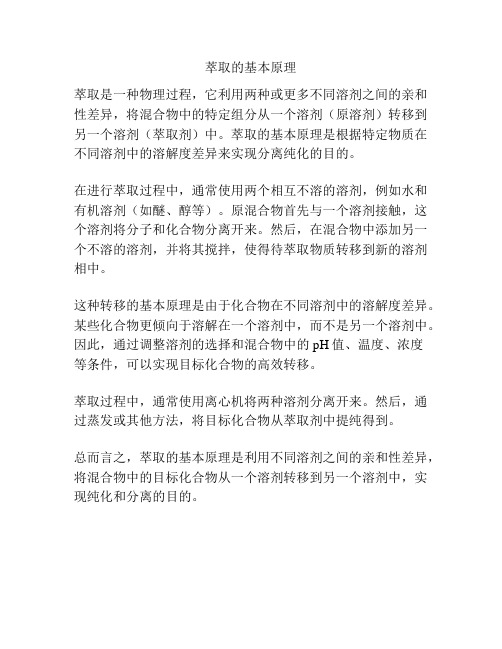
萃取的基本原理
萃取是一种物理过程,它利用两种或更多不同溶剂之间的亲和性差异,将混合物中的特定组分从一个溶剂(原溶剂)转移到另一个溶剂(萃取剂)中。
萃取的基本原理是根据特定物质在不同溶剂中的溶解度差异来实现分离纯化的目的。
在进行萃取过程中,通常使用两个相互不溶的溶剂,例如水和有机溶剂(如醚、醇等)。
原混合物首先与一个溶剂接触,这个溶剂将分子和化合物分离开来。
然后,在混合物中添加另一个不溶的溶剂,并将其搅拌,使得待萃取物质转移到新的溶剂相中。
这种转移的基本原理是由于化合物在不同溶剂中的溶解度差异。
某些化合物更倾向于溶解在一个溶剂中,而不是另一个溶剂中。
因此,通过调整溶剂的选择和混合物中的pH值、温度、浓度
等条件,可以实现目标化合物的高效转移。
萃取过程中,通常使用离心机将两种溶剂分离开来。
然后,通过蒸发或其他方法,将目标化合物从萃取剂中提纯得到。
总而言之,萃取的基本原理是利用不同溶剂之间的亲和性差异,将混合物中的目标化合物从一个溶剂转移到另一个溶剂中,实现纯化和分离的目的。
萃取的原理
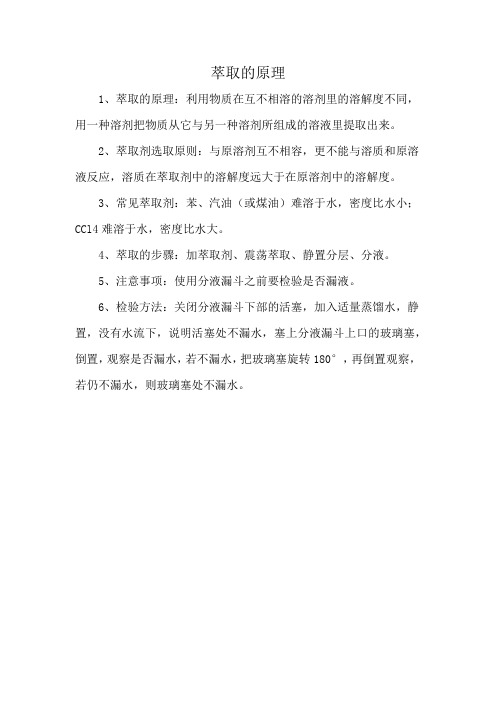
萃取的原理
1、萃取的原理:利用物质在互不相溶的溶剂里的溶解度不同,用一种溶剂把物质从它与另一种溶剂所组成的溶液里提取出来。
2、萃取剂选取原则:与原溶剂互不相容,更不能与溶质和原溶液反应,溶质在萃取剂中的溶解度远大于在原溶剂中的溶解度。
3、常见萃取剂:苯、汽油(或煤油)难溶于水,密度比水小;CCl4难溶于水,密度比水大。
4、萃取的步骤:加萃取剂、震荡萃取、静置分层、分液。
5、注意事项:使用分液漏斗之前要检验是否漏液。
6、检验方法:关闭分液漏斗下部的活塞,加入适量蒸馏水,静置,没有水流下,说明活塞处不漏水,塞上分液漏斗上口的玻璃塞,倒置,观察是否漏水,若不漏水,把玻璃塞旋转180°,再倒置观察,若仍不漏水,则玻璃塞处不漏水。
- 1、下载文档前请自行甄别文档内容的完整性,平台不提供额外的编辑、内容补充、找答案等附加服务。
- 2、"仅部分预览"的文档,不可在线预览部分如存在完整性等问题,可反馈申请退款(可完整预览的文档不适用该条件!)。
- 3、如文档侵犯您的权益,请联系客服反馈,我们会尽快为您处理(人工客服工作时间:9:00-18:30)。
Байду номын сангаас• 酸的浓度应适合于电积
Solvent Extraction Equipment – The Mixer Settler
溶剂萃取设备-混合室澄清室
Pump mixer Secondary mixer 抽吸混和室 二级混和室
Distribution fence 分散栅栏
Cu Solvent Extraction Chemistry
• Hydroxyoxime reagents are used to selectively EXTRACT copper from the PLS into the organic phase;
2RH + CuSO4 → R2Cu + H2SO4
Basic Principles of
Solvent Extraction 溶剂萃取基本原理
Historical development 历史发展
• The first commercial extractants developed for the mining and metallurgical
< 1.5
Autoclave/agitation加压浸出/搅浸 2 – 20
pH 1.5 – 2.2 1–2 1–2 <1 - 2
However, the PLS always contains some undesirable impurities 然而,料液仍然含有一些不想要的杂质
Typical PLS constituents 典型的料液成分
• Nitrate - can degrade organic (particularly modified reagents). 硝酸根-能够降解有机相(特别是改型的萃取剂)
• Silica and suspended solids - causes crud formation and accentuates physical transfer of impurities to EW. 硅和悬浮颗粒-导致第三相的形成和会加剧杂质传递到电积
process a few years later, in the 1960‘s.
随后在六十年代,相同的科学家也设计出了铜萃取工艺(CuSX)。
• The first Cu SX plant was commissioned in 1968 in the S.W. USA, Ranchers
Exploration Bluebird mine, using LIX 64N.
industry were used in processing uranium ores. 在采矿和冶炼工业中第一个被商业运营的萃取剂是用于铀矿石的处理。
• First developed in the 1950’s, D2EHPA (Dapex process) was replaced by
Alamine® 336 tertiary amine in 1958 due to better efficiency. 在五十年代被发展, 由于更高效,在1958D2EHPA被Alamine ®336叔胺所取 代。
• Alamine was developed by General Mills Chemicals Inc., now Cognis
Corporation.
Alamine是由通用矿物公司发明的,现属于科宁公司。
• The same scientists conceived of the copper solvent extraction (CuSX)
Specific gravity of organic phase ~ 0.8 有机相比重~0.8
Aqueous droplets surrounded by organic phase Organic Continuous emulsion 水相小液滴被有机相包裹 有机相连续乳状液
Specific gravity of aqueous phase > 1.0 水相比重~1.0
Scrub AC – to minimise aqueous entrainment in WLO. 洗涤段 水相连续-将水相夹带入洗涤负载有机相降到最低。
Strip OC – to minimise organic entrainment to EW. 反萃 有机相连续-将有机夹带入电积降到最低。
今天世界上大约有3/4的铀是通过溶 剂萃取的方法生产的
Olympic Dam SX Plants 溶剂萃取厂
The Aim of Copper Solvent Extraction (SX) 铜溶剂萃取的目标
“To PURIFY and UPGRADE the copper content of an aqueous solution suitable for end product processing.” “来净化和浓缩液相溶液中的铜浓度使之适合于最终产品 生产”
Stripped Organic + PLS Loaded Organic + Raffinate
Organic recycled to Extraction • Strong acid is used to STRIP copper from the organic phase
back into an aqueous phase (eg, electrolyte suitable for EW);
The process always uses leaching before SX, and usually uses Electro-Winning (EW) following SX. 工艺在溶剂萃取之前始终使用浸出,并且在溶剂萃取之后 使用电积。
Leaching produces an impure Pregnant Leach Solution (PLS). 浸出产生不纯的浸出母液。
Spent Electrolyte 废电积液
Cu
Cu
Cu
Cu
Acid
LEACH
EXTRACT
STRIP
EW
酸
铜浸出
铜萃取
铜反萃
PLS 料液
Loaded Organic 负载有机相
Strong Electrolyte 电积富液
Cu2+
Emulsion mixing and separation – OC 乳状液混合和分相-有机相连续
R2Cu + H2SO4
Loaded Organic + Spent Electrolyte
→ 2RH + CuSO4
Stripped Organic + Strong Electrolyte
• Acid concentration should be suitable for Electrowinning (EW)
Typical PLS Cu concentration from different
Leach process sources 来自不同浸出工艺的典型料液铜浓度
PLS source 料液来源
料液 PLS Cu, g/l
Oxide ore 氧化矿
3–8
Chalcocite辉铜矿
1.5 – 4
Chalcopyrite (dump)黄铜矿
• Most important species include copper, acid, iron, chloride, manganese, nitrate, dissolved silica and solids. 最重要的种类包括的是铜、酸、铁、氯、锰、硝酸根、被溶解的硅和固体颗 粒。
• Copper - the desired pure product. 铜-想得到纯铜
今天世界上大约有1/4的铜是通 过溶剂萃取的方法生产的
Ranchers Bluebird Mine SX-EW Plant 溶剂萃取电积厂
Uranium Solvent Extraction
Today, about ¾ of the world‘s uranium is produced by SX
Organic weir
有机堰
Launders
流槽
Organic in 有机进入
Settler
Aqueous in 水相进入
Organic out 有机出口
Aqueous out 水相出口
In the mixer, the two phases form an
emulsion which separates in the settler 在混合室,两相形成一个乳状液在澄清 室分离
世界上第一个铜溶剂萃取厂在1968年投产, Ranchers Exploration Bluebird mine,使 用的是LIX 64N.
Copper Solvent Extraction 铜溶剂萃取
Today, about ¼ of the world‘s copper is produced by SX
• Acid - residual acid after leaching affects economics of SX copper recovery. 酸-浸出后的残留酸影响溶剂萃取铜的回收经济。
• Iron - can be transferred to EW, affecting EW efficiency. 铁-能够被传递到电积,影响电积效率
E1 AC if no crud – to minimise PLS entrainment in LO.
…..But, if crud present, then run OC 一萃 水相如果没有第三相-将料液夹带入负载有机相降到最 低。
